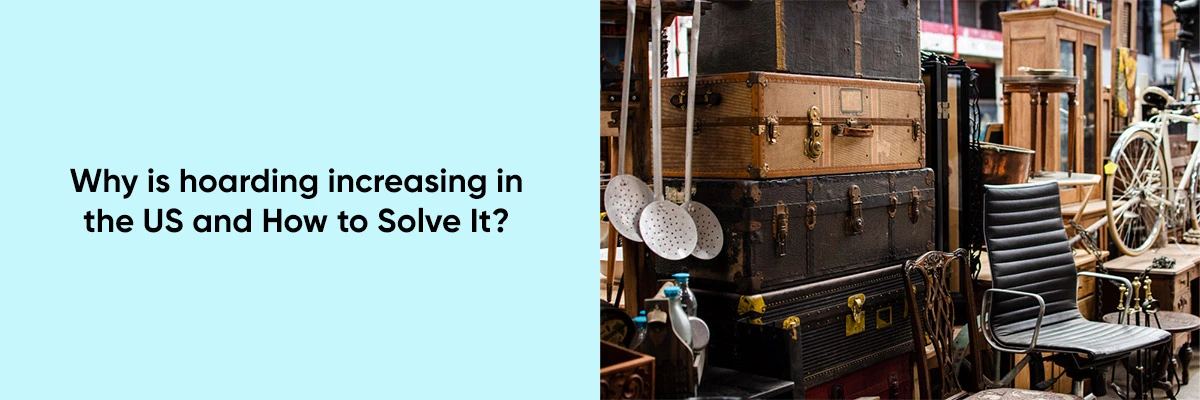Hoarding, a complex issue frequently misunderstood, has become more prevalent in the United States in recent years. It’s not merely about excessive clutter; rather, it’s a psychological condition entwined with emotional, mental, and behavioral factors.
Understanding why hoarding is on the rise and exploring effective solutions is crucial for individuals, communities, and mental health professionals alike, especially for fair housing compliance.
Why Hoarding is Increasing
Several factors contribute to the escalating prevalence of hoarding:
- Consumer Culture: The culture of consumerism encourages excessive acquisition and attachment to material possessions. This fosters a mindset where discarding items becomes emotionally challenging.
- Trauma and Loss: Hoarding behavior can emerge as a coping mechanism after traumatic experiences or significant losses. Individuals may attach sentimental value to objects, associating them with security or memories.
- Social Isolation: Loneliness and social isolation can trigger hoarding tendencies. Possessions may serve as substitutes for meaningful relationships or fill the void of companionship.
- Mental Health Conditions: Hoarding often coexists with mental health issues like anxiety, depression, or obsessive-compulsive disorder (OCD). These conditions can exacerbate hoarding behaviors.
- Media Influence: Reality TV shows have sensationalized hoarding, potentially normalizing or glamorizing the behavior rather than highlighting its underlying complexities.
Hoarding and Fair Housing Compliance
Hoarding often intersects with fair housing laws, presenting a delicate balance between supporting individuals with hoarding disorder and ensuring property safety and compliance. The Fair Housing Act prohibits discrimination based on disabilities, including mental health conditions such as hoarding disorder.
- Reasonable Accommodations: Housing providers are required to make reasonable accommodations for individuals with disabilities, including those with hoarding disorder. This might involve adjusting policies on clutter or providing additional support to accommodate their needs.
- Collaborative Approach: Housing providers, along with mental health professionals and social service agencies, should adopt a collaborative approach. This involves understanding the challenges faced by individuals with hoarding tendencies while addressing safety and health concerns within the property.
- Individualized Solutions: Implementing individualized plans tailored to the needs of tenants with hoarding disorder is crucial. This could involve regular check-ins, support services, and creating a plan to address clutter while respecting the individual’s autonomy.
- Documentation and Communication: Proper documentation of communication and collaboration with the tenant is essential. It establishes a clear record of efforts made to accommodate the tenant’s needs while ensuring compliance with property safety standards.
- Education and Training: Housing providers, property managers, and staff should undergo training to recognize hoarding disorder, understand its complexities, and learn effective communication strategies to address these issues sensitively and effectively.
- Balancing Safety and Support: Balancing safety concerns with providing support for individuals with hoarding disorder is pivotal. It requires a nuanced approach that prioritizes the well-being of the individual while ensuring the safety and livability of the property for all occupants.
How to Solve Hoarding
Addressing hoarding requires a multifaceted approach involving compassion, education, and support systems. Here are strategies for tackling this issue:
- Education and Awareness: Promote understanding about hoarding as a mental health issue rather than a lifestyle choice. Increased awareness can reduce stigma and encourage early intervention.
- Professional Intervention: Seek help from mental health professionals, therapists, or organizers experienced in hoarding disorder. Cognitive-behavioral therapy (CBT), motivational interviewing, and medication (if needed) can aid in managing hoarding behaviors.
- Support Groups: Establish or join support groups where individuals can share experiences, gain insights, and receive encouragement from others dealing with similar challenges.
- Gradual Decluttering: Emphasize gradual, non-confrontational decluttering approaches. Encourage sorting possessions into categories (keep, donate, discard) to help individuals make informed decisions.
- Community Involvement: Collaborate with local authorities, social services, and community organizations to provide resources, such as waste disposal services, counseling, and housing assistance.
- Family and Friend Support: Encourage a supportive environment where loved ones provide empathy, patience, and practical assistance without judgment.
- Prevention and Early Intervention: Educate younger generations about responsible consumption and attachment to possessions to prevent hoarding behaviors from developing.
Conclusion
Hoarding is a multifaceted issue that demands a compassionate and comprehensive approach. Fair housing compliance in the context of hoarding disorder requires a delicate balance between providing support, respecting individual rights, and maintaining property safety. By adopting a collaborative, empathetic, and informed approach, housing providers can navigate these complexities while ensuring that individuals with hoarding disorder receive the necessary assistance without facing discrimination. Striking this balance is essential to foster inclusive, supportive communities while upholding fair housing regulations.


